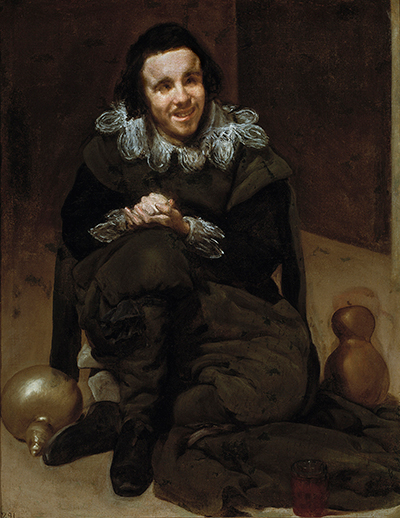Diego Velazquez would produce two portraits titled The Jester Calabacillas, and we tend to identify them from their locations today, with one found in the Cleveland Museum of Art, US, whilst the version displayed here is a part of the extensive Velazquez collection in the Prado Museum in Madrid.
The Prado Museum themselves actually refer to this painting as The Buffoon Calabacillas and have dated it loosely at 1635 - 1639. Velazquez was entirely established by this point in his career and was able to work without too much financial pressure in his life. He would commonly depict the royal family within his work, but sometimes would also cover some of the elements that surround them, be it fringe members of the family or some of their servants, as found here. The genre known as hombres de placer was popular within Spanish art and society at the time, and included a number of other roles too, with dwarfs also featuring prominently. Whilst they were employed for entertainment, their inclusion within portraiture would sometimes be in order to make others look better in comparison to them. This would make most of us today fairly uncomfortable, but was entirely acceptable within 17th century European society.
Research has been unable to confidently identify the individual within this portrait, but several names have been put forward. The most likely explanation would be that of Juan Calabazas, someone who was documented as serving his role from 1632 to 1639 and the dates certainly match up in that regard. The composition itself features him sat on the floor with an expression which feels consistent with the types of characters that fulfilled these roles, with enthusiasm and informality. He looks ready to entertain even at this point and this type of entertainment was refreshing during the formal periods of life at this time. His outfit is dark, offering little detail other than the frills around his neck and wrists. Several elements of his show are to be found alongside in order to aid the viewer in deciphering the scene, though the title itself is already enough of a clue.
The collection of Velazquez paintings to be found in the Prado Museum remains one of the highlights of the artistic offering of this entire city, though there is so much more to see for those lucky enough to find themselves with time to spare in this historic location. Not far away are a series of other notable museums and art galleries, some of which focus on more recent art movements, such as Cubism, but within the Prado alone you will find a rich mixture of European paintings and sculptures from the Renaissance up to the present day. One cannot ignore the significance of Francisco de Goya, and many of his paintings are featured here, as well as notable pieces from the likes of El Greco and also Hieronymus Bosch - see The Garden of Earthly Delights for perhaps the best example of his own artistic brilliance. All-in-all, much to see and enjoy for most tastes.




